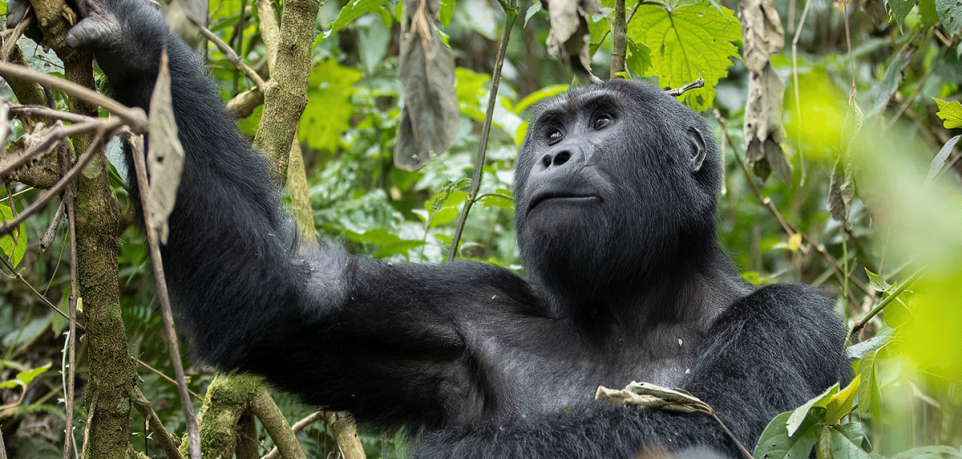
Mountain Gorilla Reproduction: A male gorilla can weigh up to 180 kg, and females typically weigh 90 kg, making them the biggest living apes and largest primates. Since humans and gorillas share about 98% of their genetic composition, they resemble humans more in personality and conduct. The emotions of joy and grief, social relationships and physical appearance which shows that both humans & gorillas have got four limbs, are some of the similarities. There are thought to be 1063 mountain gorillas in the entire globe.
Each of the two gorilla species, western and eastern gorillas has two subspecies. The Cross River Gorilla and Western Lowland Gorilla are the two additional subspecies of western gorillas, whilst Eastern gorillas are further separated into Eastern Lowland Gorillas (known as Grauer's Gorillas) and renowned and endangered Mountain Gorillas.
Gorillas are considered newborns until they reach the age of 8, at which point they are referred to as adults. Male adults aged 8 to 12 are known as black backs, and once they turn 12, they are known as silverbacks because they have begun to develop gray hair on their backs.
Female gorillas give birth to their first babies once they are around ten years and have an 8.5 months' gestation period. Multiple births, such as having twins, are extremely uncommon in gorillas. Male gorillas are polygamous in nature and usually mate with several females during their life time.
The Virunga mountain range, which is shared by Democratic Republic of the Congo, Rwanda and Uganda is home to mountain gorillas as well as Bwindi Impenetrable National Park in southwestern Uganda. These apes differ from their lowland counterparts in that they have longer hair and shorter arms, as well as muscular arms and chests and large hands and feet. In comparison to other gorilla species, they also weigh less—roughly between 300 and 485 pounds. They are the only ones who inhabit higher altitudes, and their thick, lengthy fur keeps them warm by protecting them from the cold.
Similar to humans, they too live in families. The majority of these families have more than 10 members, with the silverback serving as the alpha male. Both males and females are in charge of raising the young; as males get older, they typically break away from their families to form their own or join another. Larger gorilla groups frequently fight, and the females' relationship with the dominant silverback is crucial to the group's stability. Gorillas are more composed, tranquil, tenacious, and intellectual. Together, they sleep in nests they have built on both trees and the ground. They enjoy cuddling together during the night.
They spend over six hours every day feeding on leaves, roots, fruits, and small insects as well. Their lifespan can reach 40 years, especially if they are left in the wild alone.
In Rwanda's Volcanoes national park, which is home to over 300 mountain gorillas, visitors can encounter these primates seamlessly. There are 12 habituated gorilla groups in this area that can be trekked. One of these include Susa group, which resides high on Mount. Karisimbi and was studied by renowned primatologist Dian Fossey. Rwanda is the most costly country to visit because gorilla trekking permits here cost $1500 each. In the month of September every year in Musanze, the primary town for gorilla safaris, Rwanda organizes an annual ceremony where young gorillas are named.
The best mountain gorilla trekking experience in Uganda can be obtained in Bwindi Impenetrable National Park. Comprising of 21 groups with about 600 gorillas in total. However, some more can be found in Uganda's second gorilla destination - Mgahinga Gorilla National Park. There is only one group here, which is fully habituated for visitation every day. Although Bwindi impenetrable is as inaccessible as it sounds, it does provide gorilla habituation experiences where you can spend about four hours with a semi-habituated group. Because the members of this group are unpredictable, this is a much more exciting experience than with habituated gorillas where you can be sure they are accustomed to humans. The cost of this activity is $1500 and gorilla trekking which is relatively cheaper in Uganda than in Rwanda goes for $700.
Virunga
National Park in Democratic Republic of Congo also provides gorilla
trekking adventures. Within the Virunga Mountains, it provides the most
daring and affordable options; the permits only cost $450. Although
there are only 7 gorilla groups in the park, security is still a concern
there. It is therefore advised to visit the gorillas as part of a
planned tour where all aspects, including security, are taken care of.
A large population of Grauer's gorillas, sometimes known as Eastern Lowland gorillas, which are over 5,000 can also be found in the D.R. Congo within the Kahuzi-Biega National Park, home to both mountain and lowland gorillas, making D.R. Congo the only country to host both gorilla species.